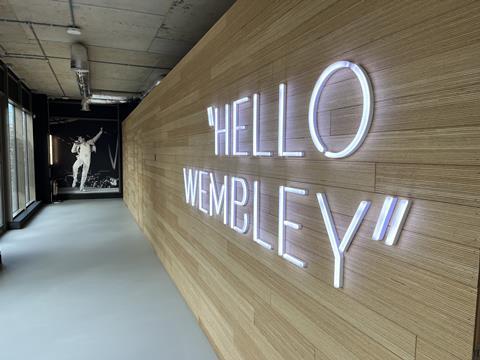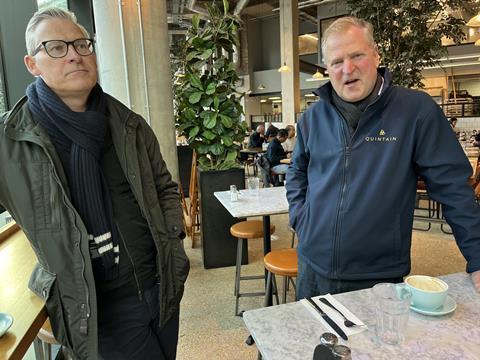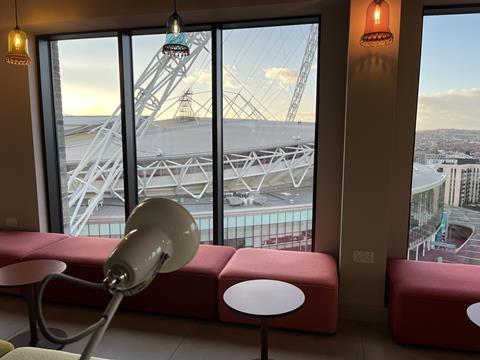The firmŌĆÖs chief executive James Saunders tells Dave Rogers whatŌĆÖs been going on at the site with the famous name and whatŌĆÖs next
ŌĆ£When I joined here, I had three children. IŌĆÖve now got five.ŌĆØ As a former brand director at Coca-Cola, James Saunders, for the past three years chief executive of Wembley Park developer Quintain, smiles when itŌĆÖs put to him the strapline for the firm could be: ŌĆśWork at Quintain and have more kidsŌĆÖ.
As well as SaundersŌĆÖ expanding brood, the company he runs has been doing some growing of its own in recent times, having last year celebrated two decades of being in this area of north-west London after paying ┬Ż48m for an initial 44 acres of land in August 2002.
Since that deal, Saunders reckons the firm has pumped around ┬Ż2.5bn into the estate, now nearly double at 85 acres, which was once a byword for being the home to a historic but crumbling stadium, a swathe of unsightly industrial units, dozens of burger vans on Cup Final days and not much else.

It became even more globally famous with the Live Aid concert in 1985 and the 56-year-old was a regular visitor himself in his teens and 20s ŌĆō though he never got to the Live Aid gig. ŌĆ£I used to come here for the big summer concerts,ŌĆØ he recalls. ŌĆ£The Stones, Springsteen. I loved the events but thought the experience was poor. You might get a hot dog, go to the event and then leave.ŌĆØ
York House was one of the original, unloved office blocks at Wembley but under the redevelopment has been turned into a co-living space, operated by Dandi Living. ŌĆ£No one lived here in those days. YouŌĆÖd have one janitor in York House,ŌĆØ adds Saunders.
Anyone who visited Wembley back then usually has a war story of their own to tell: the battle to get out of Wembley Park tube, the shuffle down Wembley Way, actually called Olympic Way ŌĆō ŌĆ£we wonŌĆÖt argue about that one,ŌĆØ Saunders says ŌĆō and the plod up a ramp, now replaced by steps, to the stadium itself for a less than impressive view of the action on the other side of the turnstiles. A half-time visit to the toilets was a customer experience for sure.
The catalyst for the change, of course, was the decision to rebuild the stadium. It was hopelessly late and over-budget, of course, nearly sank Multiplex and saw a high-profile legal battle between the main contractor and its steelwork subcontractor Cleveland Bridge take place while it was still being built (these things tend to happen after completion) but, more than 15 years on from staging its first game, the 2007 FA Cup Final, it still holds up well to newer rivals thanks to its arch, sheer size and name.

The lure of the Wembley marque is not lost on Saunders, either, who says when he joined as commercial director, he decided to rebrand the scheme to Wembley Park from its previous name of Wembley City. ŌĆ£Even though itŌĆÖs dense, itŌĆÖs not a city. For me, the brand, that Wembley-ness is incredibly important.ŌĆØ
In short, QuintainŌĆÖs work at Wembley Park over the past 20 years has seen it, among other things, build 5,000 homes, a brace of hotels, replace the conference centre with new homes, overhaul the arena, which it sold last year for ┬Ż43m to a private equity firm, bring in 50 retailers and 20 restaurants, create LondonŌĆÖs first outlet shopping emporium, open a Boxpark, build a headquarters for Brent council and create new parks and gardens.
We have benefitted enormously from being a private company with private equity because we have been able to inject significantly more capital
James Saunders
It is currently home to around 7,000 people and, by the end of the year, Saunders reckons 10,000 will be living there. When it is all done in a decade or soŌĆÖs time, around 15,000 people will call the area home with a further 5,000 students living there too.
ŌĆ£No one has built as much and as fast in a single location as we have,ŌĆØ he adds. ŌĆ£A lot of developers can do a single building but not many have the appetite to do entire districts.ŌĆØ
A few years ago, in 2018 and 2019, the firm had 3,500 builders on site, working on nine projects which were being attended to by 25 cranes. ŌĆ£It presented some logistical challenges,ŌĆØ admits the firmŌĆÖs construction director Matt Voyce.
In terms of operating activities, all of QuintainŌĆÖs work is at Wembley. It has some legacy land ownership at sites near Gatwick Airport as well as in Birmingham but it sold its 40% stake in the Greenwich Peninsula Regeneration company to Hong Kong developer Knight Dragon a decade ago.
The pace at which it could build was accelerated several years ago when US private equity giant Lone Star paid close to ┬Ż750m for it. Previously a listed company, Quintain has been in private hands since 2015. A ┬Ż3bn sale was pulled two years ago just as three private funders were preparing to submit bids, with Lone Star blaming the worsening covid-19 situation.
Saunders says going private was the making of the firm. ŌĆ£We have benefitted enormously from being a private company with private equity because we have been able to inject significantly more capital into [Wembley]. Before private equity, it was one or two buildings at a time. Now we have been able to get more done, create a greater sense of place faster and thatŌĆÖs what this project was lacking. We didnŌĆÖt have enough pace in it.ŌĆØ

For its building work, Quintain divvies up its jobs between its framework contractors Wates, Sisk, McLaren and McAleer & Rushe. Last September, Quintain awarded its biggest construction contract to date ŌĆō a ┬Ż227m deal for Sisk to build two residential buildings along with green space.
The framework was supposed to run for five years but Quintain has kept it going. ŌĆ£We can draw on their expertise,ŌĆØ says Voyce. This has been helpful as the firm has plotted a way through the maelstrom of the past year. ŌĆ£WeŌĆÖre able to bring in contractors much earlier in the process to make sure we donŌĆÖt have an issue around capacity. We want to make sure that theyŌĆÖre capable of delivering it and that weŌĆÖre not thrusting something on them that they canŌĆÖt build or at a reasonable price.ŌĆØ
Saunders would baulk at the idea of being called a developer. ŌĆ£We see ourselves as a regeneration company, a build-to-rent (BTR) developer and operator.ŌĆØ
The firm stopped building homes for private sale back in 2018 and now only builds BTR. It has a BTR operator, Quintain Living, and typically its tenants earn around ┬Ż75,000 per household and spend around a third of their wages on rent, which for a two-bedroom flat is usually between ┬Ż2,000 and ┬Ż2,300 and for a one-bed somewhere between ┬Ż1,800 and ┬Ż2,000.
Around 90% of its ┬Ż60m turnover is from rental income with the remainder largely coming from its retail operation.
Thanks to its decision to concentrate on BTR, it has not been hit by swathes of buyers pulling out of deals in the wake of rising interest rates. But, like its developer peers, it has been hit by access to finance and the amount it costs to borrow. For now, the rate hikes have not been that noticeable. That is 18 months away, Saunders says. However, he admits: ŌĆ£The market has got much tighter.ŌĆØ
Wembley Park has a 98% occupancy rate and Saunders says tenants get gyms and broadband as part of their rent which helps deal with cost of living worries. Utility bills, which are electricity costs, are typically between ┬Ż100 and ┬Ż130 a month. ŌĆ£I wish mine was,ŌĆØ he adds, ruefully.
His target audience tends to be singles, young couples and ŌĆśsharersŌĆÖ typically in their 20s and 30s, although the oldest resident is 96. Most have tended to relocate from London zones 1 or 2, in search of something a bit smarter. ŌĆ£Some work locally, others from home, others will commute into the City or Canary Wharf.ŌĆØ

Overseas students, especially those from China, are also attracted to the area and its cluster of new buildings which have been designed by a variety of architects including HTA, Grid, Coffey and Flanagan Lawrence.
Saunders reckons it still has another decade of new build and infill sites to go, a building programme which will also include offices. It has planning consent for 800,000ft2 of offices and last year Casio, the Japanese electronics firm best known for its watches and calculators, took space at the site along with a local firm, affordable housing provider Network Homes.
We contracted to focus on Wembley but we have the skillsets to go elsewhere
Matt Voyce
He says the office sector is still recovering from the ravages of the pandemic but adds: ŌĆ£They are an important component of mixed-use regeneration.ŌĆØ
For Voyce one of his most pressing concerns is the regulatory changes following the Grenfell fire nearly six years ago. He says it had very little combustible cladding to replace in the immediate aftermath of the disaster but says firms like Quintain are having to second-guess what might be prescribed by future legislation on a range of issues such as carbon reduction, second staircases in new blocks over 30m and net zero. ŌĆ£End to end, [a build] can take six years. How do you design and future-proof something that might not be built for another four or five years? It creates uncertainty and the government has not really helped in that regard.ŌĆØ
Once its work at Wembley Park is done, Saunders says QuintainŌĆÖs aim is to take its construction and development teams ŌĆō and their knowledge and expertise ŌĆō to different parts of the country. Before it focused exclusively on the HA9 postcode, the firm, which employs 250 people, had projects in Middlesbrough, Bristol and Birmingham. ŌĆ£There may not be other Wembleys but there are plenty of mixed-use regeneration sites. We contracted to focus on Wembley but we have the skillsets to go elsewhere.ŌĆØ

Before he heads back to his office at the Civic Centre, the ┬Ż75m scheme designed by Hopkins and built by Skanska a decade ago, Saunders tells the story of one of his most pleasing ŌĆō if surprising ŌĆō achievements. It took a while to convince the stadium that ripping out the ramp up to the venue and putting in steps was a good idea. ŌĆ£You go to your neighbour, you say IŌĆÖm going to change your front door and your drive and IŌĆÖm going to pay for it. Are you happy with that? That was a conversation that took 10 years. You would now think those steps have been there forever. IŌĆÖm very proud of that.ŌĆØ
The two up top: Saunders and Voyce

Quintain chief executive James Saunders joined the firm in 2008 as a commercial director later becoming chief operating officer before being appointed to his current role in 2019. He was previously chief marketing officer at wi-fi provider the Cloud, having been a consultant at Vodafone for a year and a brand director at Coca Cola for six years between 1994 and 2000. He splits his time between his office at Wembley Park and QuintainŌĆÖs office at Great Portland Street.
A QS by background, construction director Matt Voyce joined Quintain in 2007 from Arcadis where he had been for 15 years following that firmŌĆÖs purchase of QS and project manager AYH in 2005. Born in Brighton, he lives in Essex and usually makes the trip to Wembley Park by bike to keep fit. The 52-year-old adds: ŌĆ£IŌĆÖve got two young boys so itŌĆÖs good to keep the heart going and stay mentally fresh.ŌĆØ Voyce and friends tend to head off in the summer to climbs made famous by the Tour de France and Giro dŌĆÖItalia. Alpe dŌĆÖHuez, the Stelvio and Mortirolo have all been ticked off with this yearŌĆÖs jaunt set to include the mighty Col du Galibier at 2,642m high.
HereŌĆÖs to you: Wembley ParkŌĆÖs Robinson building

Quintain has decided to give each of its buildings at Wembley Park names with some meaning. One is called the Robinson and has been designed by PRP. ŌĆ£Nothing about this building is subtle,ŌĆØ admits Saunders.
From its shocking pink interior paint job at ground floor level, to the orange interiors of the lifts and the patterned carpets the colour palette is not for the faint hearted. At roof level it has, he says, the largest deckchair in London, as well as an adult slide. ŌĆ£On a warmer day, youŌĆÖll find mattresses out here. People treat it like a resort.ŌĆØ It is mainly inhabited by students and younger couples. ŌĆ£I love this building because itŌĆÖs so extreme,ŌĆØ he adds. But back to the name. Why is it called Robinson? ŌĆ£The original concept was a 1960s Mrs Robinson/the Graduate meeting Alice in Wonderland.ŌĆØ A design brief and a half.



























No comments yet